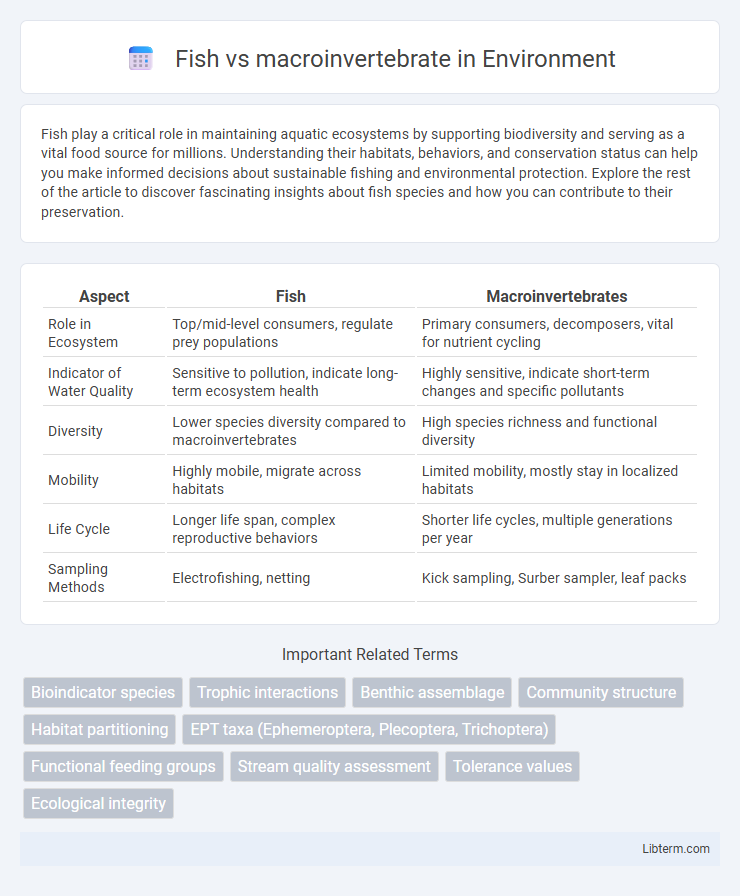Fish play a critical role in maintaining aquatic ecosystems by supporting biodiversity and serving as a vital food source for millions. Understanding their habitats, behaviors, and conservation status can help you make informed decisions about sustainable fishing and environmental protection. Explore the rest of the article to discover fascinating insights about fish species and how you can contribute to their preservation.
Table of Comparison
| Aspect | Fish | Macroinvertebrates |
|---|---|---|
| Role in Ecosystem | Top/mid-level consumers, regulate prey populations | Primary consumers, decomposers, vital for nutrient cycling |
| Indicator of Water Quality | Sensitive to pollution, indicate long-term ecosystem health | Highly sensitive, indicate short-term changes and specific pollutants |
| Diversity | Lower species diversity compared to macroinvertebrates | High species richness and functional diversity |
| Mobility | Highly mobile, migrate across habitats | Limited mobility, mostly stay in localized habitats |
| Life Cycle | Longer life span, complex reproductive behaviors | Shorter life cycles, multiple generations per year |
| Sampling Methods | Electrofishing, netting | Kick sampling, Surber sampler, leaf packs |
Introduction to Aquatic Ecosystems
Fish and macroinvertebrates serve as key bioindicators in aquatic ecosystems, reflecting water quality and habitat health. Fish, being higher trophic level organisms, respond to broader environmental changes, while macroinvertebrates, with diverse species and shorter life cycles, offer detailed insights into localized pollution and habitat alterations. Their combined analysis enhances ecosystem assessment, aiding in the sustainable management of freshwater biodiversity.
Defining Fish and Macroinvertebrates
Fish are aquatic vertebrates characterized by gills, scales, and fins, playing crucial roles in freshwater and marine ecosystems. Macroinvertebrates, which include insects, crustaceans, and mollusks, are small aquatic animals without backbones visible to the naked eye, often used as bioindicators of water quality. Both groups serve as essential components in aquatic food webs, with fish often acting as predators and macroinvertebrates functioning as primary consumers and decomposers.
Habitat Preferences and Distribution
Fish typically inhabit a broad range of aquatic environments, including rivers, lakes, and streams, often favoring areas with diverse flow regimes, submerged vegetation, and variable depths to support feeding and spawning. Macroinvertebrates generally exhibit more specialized habitat preferences, thriving in microhabitats such as riffles, leaf litter, and sediment, where they can find organic matter and shelter. Distribution patterns of fish are influenced by factors like water temperature, dissolved oxygen, and substrate type, while macroinvertebrates' distribution closely aligns with water quality and habitat complexity at a localized scale.
Life Cycles and Reproductive Strategies
Fish exhibit complex life cycles involving external or internal fertilization with stages including egg, larva, juvenile, and adult, often undergoing metamorphosis and seasonal migrations. Macroinvertebrates display diverse reproductive strategies, ranging from aquatic insects' multi-stage metamorphosis (egg, larva, pupa, adult) to crustaceans' brood care, with life cycles often linked to water quality and habitat stability. Both groups' reproductive timing and developmental stages are crucial for ecosystem functions and bioassessment in freshwater environments.
Roles in the Aquatic Food Web
Fish act as top predators in the aquatic food web, regulating populations of smaller organisms and maintaining ecosystem balance. Macroinvertebrates function as primary consumers and decomposers, breaking down organic matter and serving as essential prey for fish. Together, these groups sustain nutrient cycling and energy flow within freshwater habitats.
Adaptations for Survival
Fish possess specialized gills for efficient oxygen extraction and streamlined bodies for swift aquatic movement, enabling them to evade predators and capture prey effectively. Macroinvertebrates exhibit diverse morphological adaptations such as hardened exoskeletons, claws, and camouflage, facilitating protection and resource acquisition in various freshwater habitats. Both groups have evolved sensory adaptations, with fish relying on lateral lines to detect vibrations and macroinvertebrates using antennae and setae for environmental perception, enhancing their survival in dynamic ecosystems.
Bioindicators of Water Quality
Fish serve as bioindicators of water quality by reflecting long-term environmental changes and ecosystem health due to their sensitivity to pollutants, oxygen levels, and habitat alterations. Macroinvertebrates, including insects, crustaceans, and mollusks, provide immediate and localized indicators of water pollution because of their varying tolerance to contaminants and rapid population responses. Both fish and macroinvertebrate assemblages are essential in biological monitoring programs, with fish indicating broader ecological impacts and macroinvertebrates offering precise detection of specific water quality impairments.
Threats and Conservation Challenges
Fish populations face threats such as habitat fragmentation, water pollution, and overfishing, which disrupt aquatic ecosystems and reduce biodiversity. Macroinvertebrates are highly sensitive to water quality degradation, including chemical contaminants and sedimentation, making them vulnerable to environmental changes. Conservation challenges include balancing ecosystem protection with human activities, restoring habitats, and implementing effective monitoring to safeguard both fish and macroinvertebrate communities.
Importance in Ecological Monitoring
Fish provide key indicators of overall aquatic ecosystem health, reflecting long-term water quality and habitat conditions due to their position in the food web. Macroinvertebrates offer sensitive and immediate responses to environmental changes, making them essential for detecting localized pollution and habitat disturbances. Combining fish and macroinvertebrate assessments enhances the accuracy of ecological monitoring by covering multiple trophic levels and temporal scales.
Comparative Summary and Future Perspectives
Fish exhibit higher trophic mobility and bioaccumulation capacity compared to macroinvertebrates, which have greater density and diversity, making them sensitive indicators of aquatic ecosystem health. Both groups serve complementary roles in biomonitoring, with fish reflecting longer-term environmental changes and macroinvertebrates providing fine-scale, rapid responses to pollution and habitat alterations. Future research should enhance integrative biomonitoring frameworks combining fish and macroinvertebrate data, leveraging molecular tools and ecological modeling to improve assessment accuracy and support sustainable freshwater management.
Fish Infographic

 libterm.com
libterm.com